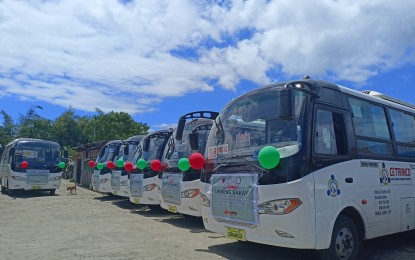
MODERN TRANSPORT. Some of the modern buses plying routes in Tacloban City are on display in this undated photo. The Land Transportation and Franchising Regulatory Board (LTFRB) said the absence of a local public transport route plan hinders the modernization of public transport in Eastern Visayas. (Photo courtesy of LTFRB Region 8)
TACLOBAN CITY – The absence of a local public transport route plan is the main hindrance why some transport companies are slow in implementing the modernization of public transport in Eastern Visayas region, an official of the Land Transportation and Franchising Regulatory Board (LTFRB) said Monday.
LTFRB Eastern Visayas Transportation Development Chief Christopher Capistrano said of the six provinces, seven cities, and 139 towns in the region, only 46 managed to submit their route plan to LTFRB field office.
The plan is one of the minimum requirements prescribed for the issuance of public utility vehicle franchises.
The document covers plans of local governments from studies on current number of passengers in every destination, the needed units that will provide a particular route, and types of public transport units.
“We need to know the exact population to provide the enough number of transport vehicles and its type to provide mobility services to the commuting public,” Capistrano said in an interview.
The document is also needed by banks if the transport cooperative is seeking a loan to acquire the modern public utility vehicles.
The region has 81 transport cooperatives and 46 corporations. As of mid-June, only 13 are implementing the modernization program. This covers 335 out of 3,202 existing public utility jeepneys, 66 out of 1,096 vans, and 53 out of 258 buses.
“We have a long way to go, and we hope that the approval of those units that are now pending in banks will be resolved finally,” Capistrano added.
Development Bank of the Philippines (DBP) Lending Center chief Michael Rodrigo Mondoy said their main office has requested for the list of transport cooperatives that have pending applications with them.
“Because they will help us follow-up with the Department of Transportation or with the LTFRB to facilitate the approval of the route plan,” Mondoy said.
DBP is implementing Program Assistance to Support Alternative Driving Approaches Financing Program, in support of the National Government’s Public Utility Vehicle Modernization Program, a special loan financing facility that caters to corporations and cooperatives registered with the Office of Transport Cooperatives.
The modernization program provides 5 percent equity for the transport cooperative, but this will be answered by the government through an amount of PHP160,000 per unit while the bank will finance the 95 percent, with an interest of 6 percent per year and payable for seven years.
A six-month grace period is also given to the transport cooperative before starting to pay their loan.
Aside from DBP, transport cooperatives and corporations may also apply for loans at the Landbank of the Philippines. (PNA)
